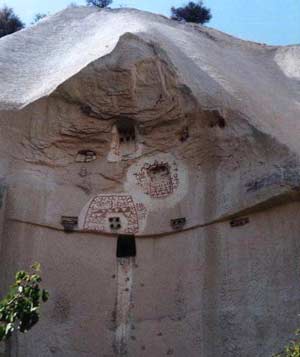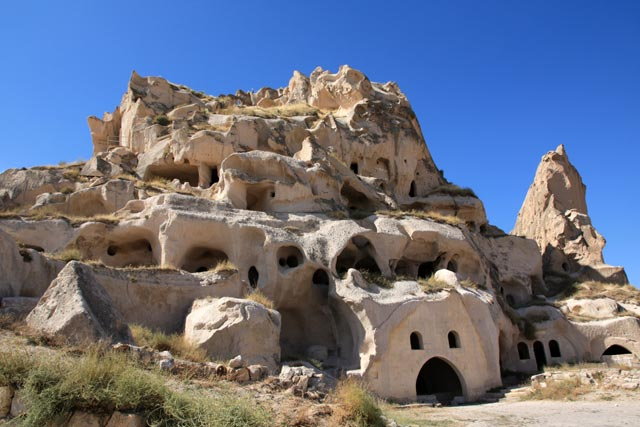Secrets of underground castle in Cappadocia
In 1963, at the Drinkuer village in Cappadocia plateau 360 km from the ancient capital of Ankara - Turkey, a farmer when digging soil in his garden accidentally discovered a cave gate.
The 5,000-year-old underground castle is full of mysteries in Turkey
If you go deep into the cave through 8 floors of the corridor, you can see an underground castle intact. The two sides of the interwoven tunnel are built with numerous houses, churches, alleys, wells and food storage rooms, and even a burial ground for burial. In the cave, there are 52 ventilation holes facing the ground, which are very camouflaged, some tunnels make a miraculous escape route.
 Stone columns are decorated with sculptural patterns.(Photo: cromwell-intl)
Stone columns are decorated with sculptural patterns.(Photo: cromwell-intl)
As expected, such underground scale can ensure safety for two thousand people living in it . Two years ago, an underground Cappadocia-like maze near Kemeckli was also unearthed. What makes people surprised here is: 2 underground underground city is a whole body connected through a 10km long tunnel.
So far, archaeologists have discovered 36 underground cities with different scales. The small underground citadel can be called an underground village enough to accommodate dozens of families, the largest is still two underground cities of the same size as the city connected together in Cappadocia plateau. Currently excavation work is still underway, as it is estimated that more than 100 underground cities will be found.

Prior to its discovery, archaeologists in Cappadocia discovered thousands of underground tunnels in the lava layer. These churches are chiseled in small rocky mountains or on high cliffs. There are quite spacious churches, lava is very elaborately carved art form into arches, cylinders, pyramids. Each stone surface and stone columns are decorated with sculptures and patterns. They are very vividly depicted, illustrating Bible stories and both Eastern and folk legends. Even household appliances such as the altar, dining table, recliner, bed in the reading room, bedroom and the kitchen of the Taoists living here are all made of stone.
So, how are these reef walls formed, how are the stone furniture in the rooms made?
With the purely manual level of labor that the workers of that era had chiseled such large rooms in very hard limestone mountains ? Could it be because of the spirit of perseverance they won the natural power, and through many generations they completed these works. But, it is also possible that large-scale volcanoes in ancient Cappadocia sprayed lava to form tunnels. After that, the more dense digger formed these underground citadel. That is the result of the impact of human power combined with the power of nature.
So, who are the earliest residents of these underground cities? Certainly they are not aborigines but people from other remote lands who came here to flee. The reason they chose Cappadocia because this land was deserted without human footprints so it did not attract the attention of outsiders. The villagers initially used stone to build their houses, but then they discovered that no house was as strong as a house carved directly by stone, initially outside the rocky surface, then they gradually built in. The mountain's core and widened into underground.

During the Byzantine Empire , only Cappadocia was safe. Christian believers and devout clergy all find their way back to Cappadocia. Therefore, Cappadocia suddenly became a holy place, those who wanted to cultivate, evangelize or want to reside must inevitably build many churches, religious monasteries and underground villages that made the scale of underground cities stop expanding.
At the end of the 12th century or the beginning of the 13th century, the Byzantine Empire gradually perished.The Cappadocians began to flee the four directions, or they could run to the West to live with Christians, or they could change religion to live with Muslims in Arabian villages.
In fact, since the end of the 17th century, an emissary of Louis XIV of France discovered underground citadels and chapels on Cappadocia plateau. He returned to Europe to declare this important discovery but no one believed, people still thought he was crazy. Less than a century later, the more people discovered strongholds and underground schools, the more time Cappadocia became famous. As pilgrims go to the holy land as a festival, archaeologists also spend much effort on this land. However, how the underground strongholds have been built and where the earliest residents living here and where they go so far are still a mystery without an answer.

Figure simulating the underground city of Derinkuyu.
- Goreme National Park and Cappadocia rocky area
- 7 impressive scale works underground
- 10 incredible underground cities in the world
- Difficult mystery story in Edinburgh castle
- Ancient chessboard in secret room in 13th century castle
- Visit the world's most beautiful castles
- Secretly discovered in the medieval castle
- Giant mushroom valley in Turkey
- The story strayed into the underground world of the 5-year-old boy, confusing the scientists
- The room places the throne in the ruins of an old castle
- Taking photos of the medieval castle, seeing people wearing mysterious black robes?
- Discovered a 600-year-old house underground
 The truth about the mysterious red-haired giant at Lovelock Cave
The truth about the mysterious red-haired giant at Lovelock Cave Inunaki Tunnel: The haunted road leading into Japan's 'village of death'
Inunaki Tunnel: The haunted road leading into Japan's 'village of death' The mystery of the phenomenon of human reflection before dying
The mystery of the phenomenon of human reflection before dying 6 mysterious phenomena, although science has been developed for a long time, still cannot be answered
6 mysterious phenomena, although science has been developed for a long time, still cannot be answered The Great Underground Constructions of the Ancient World
The Great Underground Constructions of the Ancient World  The truth about the discovery of an underground city of 'reptilians' in Los Angeles
The truth about the discovery of an underground city of 'reptilians' in Los Angeles  Mysterious discovery: Ancient underground labyrinth temple in Egypt!
Mysterious discovery: Ancient underground labyrinth temple in Egypt!  Discovered an ancient city with a capacity of 70,000 people underground
Discovered an ancient city with a capacity of 70,000 people underground  Secret Underground Railroad - Slave's escape to freedom in the American South
Secret Underground Railroad - Slave's escape to freedom in the American South  Interesting facts about underground volcanoes on Earth
Interesting facts about underground volcanoes on Earth 